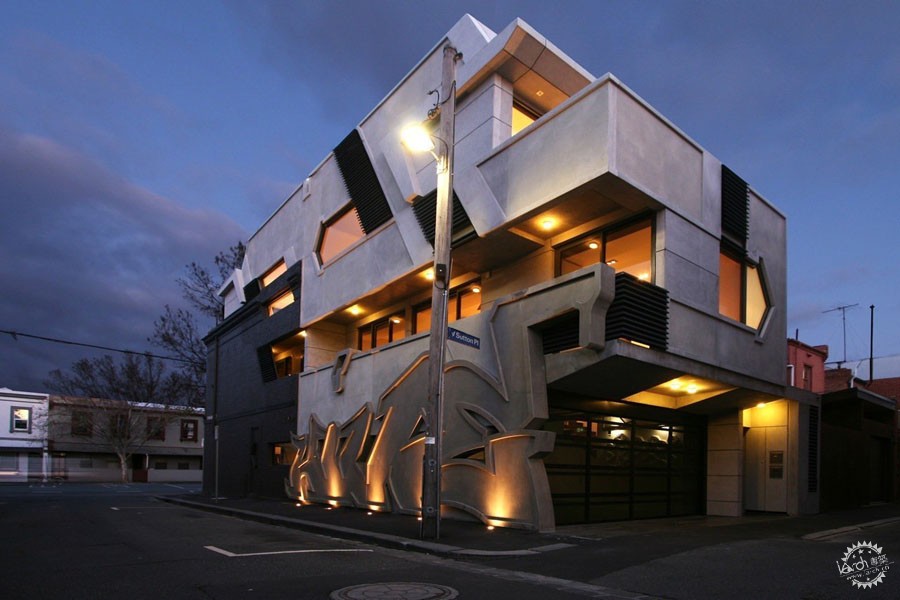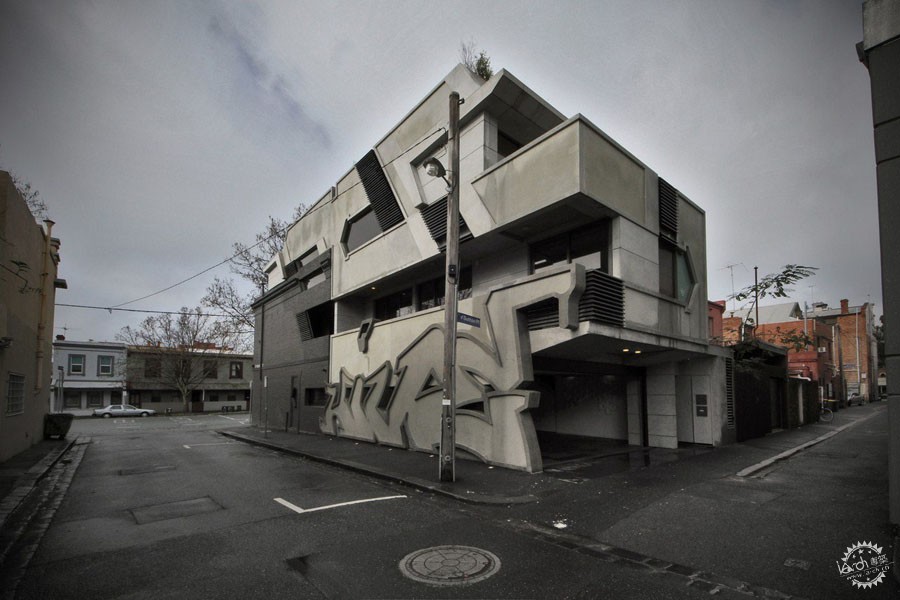
PHAT’s (Nathaniel Belcher, Stephen Slaughter) Harlem Ghetto Fabulous, 2003. Image via Metropolis Magazine. Image Courtesy of Courtesy PHAT (Nathaniel Belcher, Stephen Slaughter)
嘻哈建筑的空间塑造
How Hip-Hop Architecture is Making its Own Space
由专筑网李韧,王帅编译
本文最初发表于“Metropolis Magazine”,标题为“嘻哈建筑的Philip Johnson时刻”。
嘻哈文化来源于South Bronx家庭聚会,40多年后,这种文化已经对全球文化形成了冲击力,最基本来说,嘻哈文化对于塑造环境有着直接有力的作用。Grandmaster Flash & the Furious Five 1982年在歌曲中唱到:“Broken glass everywhere / People pissing on the stairs, you know they just don’t care/ I can’t take the smell, can’t take the noise / Got no money to move out, I guess I got no choice.”
This article was originally published in Metropolis Magazine as "Hip-Hop Architecture's Philip Johnson Moment".
More than 40 years after it emerged from South Bronx house parties, hip-hop has become a once-in-a-lifetime concussive force reshaping global cultural. But at its most elemental and foundational, hip-hop is a direct, powerful confrontation with the built environment. “Broken glass everywhere / People pissing on the stairs, you know they just don’t care,” Grandmaster Flash and the Furious Five rapped on their seminal 1982 track “The Message.” “I can’t take the smell, can’t take the noise / Got no money to move out, I guess I got no choice.”

Courtesy of the Amanda Williams and McCormick Gallery
但是,建筑也受嘻哈文化的影响。这种文化在住宅项目中、在高楼大厦的屋檐之中、在地铁的涂鸦之中大放异彩。
但是这种影响具有相互作用。诸如Nate Williams、Craig Wilkins、Amanda Williams、James Garrett Jr.等建筑师、学者、艺术家从上世纪90年代初期就开始描述受嘻哈文化所影响的建筑观点。但是在建筑师兼教授Sekou Cooke于2015年在美国雪城大学举办的一场专题讨论会之后,对于此概念的讨论愈发普及,最后以1月12日在AIA纽约建筑中心的“靠近边缘:嘻哈建筑的诞生”而告终。
本次展览由Cooke策划与设计,展览围绕着3个主要主题,即嘻哈特征、嘻哈发展过程,以及嘻哈形象,展出了来自5个不同国家21名专业人员、学者、学生的作品,类型有设计方案、3D打印模型、照片,以及艺术作品,这些作品展示在悬挂于涂鸦墙上的解构集装箱面板之上。而这也成为国际的设计模式,而这种模式仍然处于初生阶段。
Cooke告诉Metropolis的记者:“嘻哈建筑以十分深刻的方式转变为现实,这种方式比我的固有观念更加深刻。许多人也许都能够接受,嘻哈其实就是一种与建筑相关的空间,但我们需要花费一些时间来让它成为建筑的经典部分,而在这个目的达成之前,它需要有自身的特征。”
“Close to the Edge”便是一次契机,其中包含有许多必要的历史特征,例如Williams的“这是我的幼儿园”,这是混合各项媒介的拼贴成果,其中包括在停车位、广告牌、城市小空间中的各种照片,上面是许多嘻哈歌词。这项作品来源于其1997年的项目“There Are No Blank Sheets of Paper”,而这也是最早引用嘻哈文化建筑理论的项目。
From the jump, architecture inspired hip-hop. It’s poetry that bloomed in the shadows of housing projects, among the husks of burned-out high rises, and in view of subways tagged with a rainbow of graffiti.
But did the flow run the other way? Architects, academics, and artists like Nate Williams, Craig Wilkins, Amanda Williams, and James Garrett Jr. have written about, argued over, and wrangled with the idea of hip-hop-inspired architecture since the early 1990s. But after architect and professor Sekou Cooke held a symposium at Syracuse University in 2015, the discussion has intensified, culminating in Close to the Edge: The Birth of Hip-Hop Architecture, open at AIA New York’s Center for Architecture through January 12.
Curated and designed by Cooke, the exhibition is organized around three primary characteristics: hip-hop identity, hip-hop process, and hip-hop image. Mounted on panels from a deconstructed shipping container hung on graffiti-covered walls are proposals, 3D-printed models, photographs, and art created by 21 practitioners, academics, and students from five countries. Taken, together, they make the case for an international mode of design that is at once mature and still in its infancy.
“[Hip-hop architecture] has been translating into real-world building in a deeper way than I originally realized,” Cooke tells Metropolis. “I think more people are likely to acknowledge and accept that hip-hop is a space that relates directly to architecture. But it’s going to take a lot more work and a lot more time for it to become part of the canon of architecture. It might have to create its own canon before that happens.”
Close to the Edge is that cannon fodder. Included in the show are requisite historical landmarks, such as Williams’ “This is my Nursery School,” a mixed-media collage that includes hip-hop lyrics scrawled over photographs of parking lots, billboards, and urban detritus. The work is drawn from her 1997 project There Are No Blank Sheets of Paper, considered one of the earliest examples of architectural thesis work to explicitly reference hip-hop.

Amanda Williams’ “This is my Nursery School,” from There Are No Blank Sheets of Paper, 1997. Image via Metropolis Magazine. Image Courtesy of Amanda Williams
此类作品成为了真实世界的重要背景,例如明尼苏达州圣保罗的JXTA艺术中心,该项目由4RM+ULA Architects事务所设计,这便是人们所能见到的嘻哈建筑。该设计方案从多个方案中脱颖而出,其规划4层,预算为300万至350万,这座艺术中心预计于今年完工,建筑外部形态为聚碳酸酯,并且结合有LED照明系统,为城市带来暖橘色或冷蓝色的灯光。
该设计方案来源于4RM+ULA Architects事务所创始人James Garrett Jr.对于嘻哈文化的热爱。他喜爱涂鸦,因此热衷于建筑,从大学起,他就不断地探索嘻哈与建筑之间的关系,Garrett说:“这种文化表达了我是谁、我为建筑项目带来了什么。”这也帮助他的建筑事业不断向前,从明尼阿波利斯北部低预算高品质的Magic Shed+Diamond Cloud项目等多个设计方案,都不断地获得成功。
Garrett补充说:“嘻哈是潮流趋势,我们都处在这个行业中的先锋地位,但是当我们在这个位置上时,其他人不一定已经准备好接受这些文化,那么他们就有拒绝我们的理由。”
Such pieces provide crucial context for the real-world (or soon-to-be built) examples of hip-hop architecture on view, like 4RM+ULA Architects’ JXTA Arts Center in St. Paul, Minnesota. Evolving out of a 2005 proposal, the planned four-floor, $3-3.5 million center for Juxtaposition Arts, estimated to be completed this year, boasts a polycarbonate exterior with dynamic LED lighting that can radiate in warm orange or cool blue or appear as a multicolor network crisscrossing—and tagging—the building.
The design grew out of 4RM+ULA founder James Garrett Jr.’s hip-hop obsession. He was drawn to architecture by his love of graffiti, and has written about and explored the nexus of hip-hop and architecture since college. “It was a cultural expression of who I was and what I was bringing to the architecture program,” Garrett says, and it eventually fueled his practice, from the low-budget/high-utility Magic Shed+Diamond Cloud project in North Minneapolis to the numerous proposals that came just short of winning contracts.
“Hip-hop kids are trendsetters,” Garrett adds. “We’re out there first on the vanguard of what the newest best practices are in our profession. When you’re on the front edge of something, people aren’t necessarily ready for it, and there’s a rejection when people are uncomfortable.”

Sekou Cooke’s 3D Turntables: Remixing Hip-Hop Architectural Technology, 2017. Image via Metropolis Magazine. Image Courtesy of Sekou Cooke
当Garrett与4RM+ULA遭遇一些困难时,正如嘻哈自身一样,嘻哈建筑也逐渐从美国淡出。荷兰小镇哈勒姆的Boris “Delta” Tellegen是最早的欧洲涂鸦艺术家,他在2013年为一座廉价住宅综合体设计了建筑立面。Delta的作品类似街头砖石艺术,一系列的平行四边形让原本单调的建筑看起来栩栩如生。澳大利亚墨尔本Zvi Belling和他的公司ITN Architects事务所同样将嘻哈文化结合在建筑之中,从而引起了人们的广泛关注,例如The End to End大楼项目,这是一座于2015年完工的办公综合体,其顶端有着3个M-class列车,而这是早期涂鸦艺术家们的首要选择,由于这些列车的存在,这座建筑似乎在诉说着嘻哈文化的形成与发展。
但是ITN的嘻哈盛誉还来源于一个具有争议的项目“The Hive”,这是一座于2012年完工的公寓大楼,Belling和艺术家Prowla将混凝土涂鸦艺术和灰色的建筑立面相结合,许多人也认为这是对于嘻哈文化的字面解释。当2016年Cooke 在AIA纽约的讲座中展示Hive大楼时,许多人显得不屑一顾。Belling说:“涂鸦是暂时的,但是如果不进行清理,它便会永远存在于墙上。我们想通过永久的概念来尝试这种艺术,我们并没有停留在字面上,而是希望让它具有隐喻性。”
Even as Garrett and 4RM+ULA met resistance, hip-hop architecture—like hip-hop itself—veined out from the U.S. In Haarlem, Netherlands, Boris “Delta” Tellegen, one of Europe’s earliest graffiti artists, designed a facade for a low-income housing complex built in 2013. Delta’s work resembles street art rendered in brick, a series of protruding parallelograms that animate an otherwise mundane building. And in Melbourne, Australia, Zvi Belling and his firm, ITN Architects, have drawn attention for explicitly injecting hip-hop into their projects, such as The End to End Building, an office complex completed in 2015 and topped with three Hitachi M-class trains—the canvas of choice for early graffiti artists—tagged end-to-end as they would’ve been in hip-hop’s formative years.
But ITN’s hip-hop reputation was forged by the controversial The Hive, an apartment building completed in 2012. Belling and artist Prowla incorporated graffiti rendered in concrete (along with angular and arrow-shaped windows) into the gray building, which many saw as a cynical, literal interpretation of hip-hop. When the Hive was shown at a lecture Cooke gave at AIA New York in 2016, it was met with boos and derision from many in the audience. “Graffiti is usually ephemeral—it’s only on the wall until another piece comes over it,” Belling says. “We wanted to play with that, with that idea of permanence. I guess we weren’t thinking about it in terms of literal. We were trying to think of it more metaphorically.”

Courtesy of Zvi Belling
在The Hive项目的一些评论之中,隐含着对于这位白人建筑师Belling将嘻哈文化融入建筑之中的批判,而这也是个假设,这个假设说明了关于占有和包容之中更广泛的问题,换句话说,谁可以在嘻哈模式中玩建筑?Cooke认为,Hive大楼“接受了许多负面批评,因为许多人认为这个项目有些离谱,而建筑师也因此受到质疑,但是我把它纳入展览只是为了让它成为一个话题,因为嘻哈建筑还没有被普遍认可,但是也很难说这不会成为现实。”
与此同时,Cooke将他的奖金(他的下一个项目是一本书)视作是一个契机,可以成为一些不具代表性的社区的建筑通道。“这种方式依赖于较为欧洲化、白人化,以及男性化的观点,因此需要有足够多的信息来源,这样才能够形成人们能够交流的学习体系。”
Implicit in the criticism of The Hive is that Belling, a white architect, co-opted the spirit of hip-hop for the building—an assumption that speaks to a larger, existential question about appropriation and inclusion. In other words, who can practice in the hip-hop mode? The Hive “received quite a bit of negative response because people thought it was a little too on the nose, and I think the identity of the author was also being questioned,” Cooke says. “But I include it in the show just to open up that conversation. Because hip-hop architecture has yet to be ratified as a thing, it’s hard for us to say this is not it.”
At the same time, Cooke sees his scholarship (his next project is a book) as a way to give underrepresented communities an entry point into architecture. “The way that architecture is taught in schools is heavily dependent on a very Eurocentric, white, male point of view. So having alternative sources of information that actually speak to the people who are learning to produce architecture is very important.”

Hans Ulrich Obrist, Jacques Herzog, and Kanye West speak on Architecture in 2013.. Image © Seth Browarnik/startraksphoto.com, via Surface Magazine's Facebook Page
嘻哈与建筑的结合便很适合完成这个目标,在“Close to the Edge”的开幕式上,许多游客被这两种文化的诡异结合所吸引,而第一次来到AIA中心。第一次来到这里的游客Janay Anderson说:“嘻哈建筑也许更容易接受。我仍然需要进行研究,但是一般来说,建筑并不适合我,但是看待建筑需要有正确的方式,这也许就是那个正确的方式。”
就Belling而言,嘻哈成就了他的建筑。多年来,他一直沉迷于澳大利亚的各个嘻哈现场,而在这里他也看到了将嘻哈引入项目之中的诸多可能。他说:“我曾经想不到会出现嘻哈建筑,我也不敢想象。因此这种结合让我很高兴,现在已经有了这种发展趋势。”
The confluence of hip-hop and architecture is ideally suited to accomplish that goal. At the opening of Close to the Edge, numerous visitors found themselves at the AIA center for the first time, attracted by the bizarre marriage of the two cultures. “It’s a bit more accessible when I hear ‘hip-hop architecture,’” Janay Anderson, one of those AIA newcomers, said. “I still need to do my research, but in general architecture’s not accessible to me. I think it can be in the right lens, and this seems like the proper lens to look at architecture.”
And in Belling’s case, it was hip-hop that helped inform his architecture. He has been immersed in Australia’s hip-hop scene for years, and it was his interactions with that community where he began to see the possibilities of bringing hip-hop into his projects. “I would have thought it impossible at the time that there could have been such a thing as a hip-hop architecture movement,” he says. “It was something I couldn’t even conceive of. So it’s very exciting that this has happened, that it has gathered this kind of momentum.”

Filip Dujardin’s ‘Fictions’ - a series of photographic plates of fictional architectural spaces. Image Courtesy of Highlight Gallery
在“Close to the Edge”的开幕仪式上,人们都有这样一种感觉,那便是无论好坏,嘻哈建筑正在进入人们的视野之中。建筑历史学家兼建筑中心主要负责人Barry Bergdoll甚至将“Close to the Edge”和1932年由Philip Johnson主办的现代艺术博物馆展览相提并论,而后者奠定了国际式风格,Bergdoll说:“这场展览对我来说具有历史意义,其中有许多打动我的时刻,我希望在多年之后人们依旧会说,‘你还记得曾经在建筑中心的那场嘻哈概念讨论吗’。”
Cooke说自己倒是从没有进行过这样的对比,但是当在组织展览时他已经想到了这些。Cooke认为:“这并不是有意的,我希望它能够激发人们的辩论和宣传,并且在全球范围内都进行实践,在十年或是二十年之后,人们回首往事会发现,在这个时刻,建筑师的决定起到了关键的作用。”
Indeed, there was a sense at the opening of Close to the Edge that hip-hop architecture—for better or worse—is crossing over into mainstream awareness. Architectural historian and Center for Architecture board of trustees president Barry Bergdoll even went so far as to compare Close to the Edge to no less than Philip Johnson’s seminal 1932 Museum of Modern Art exhibition defining International Style. “This show, for me, is a historic moment,” Bergdoll said. “There’s a kind of vibe and excitement in the room that documents it. I hope [years from now] people will still be saying, ‘Remember that discussion at the Center for Architecture around the concept of hip-hop?’”
Cooke said he would never have made such a comparison himself—but it’s one he absolutely had in mind when organizing the exhibition. “That was completely intentional,” Cooke said. “I hope it gets debated and lectured about and talked about heavily, and then experimented with and tested on a global scale. Then, hopefully, 10 or 20 years from now, we’ll look back and say, this is a moment where architects decided to take on a different direction.”

Courtesy of Zvi Belling

Courtesy of Zvi Belling
|
|
